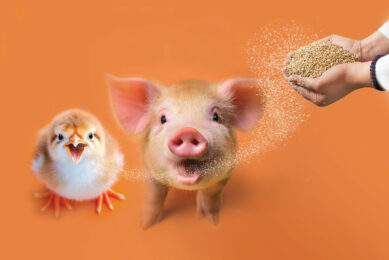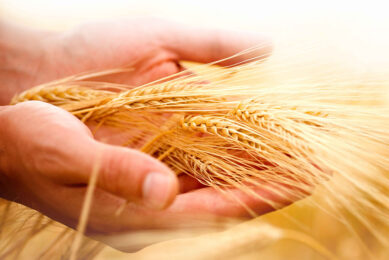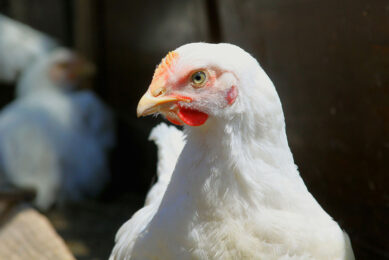Se-yeast: More inorganic Se than previously believed?
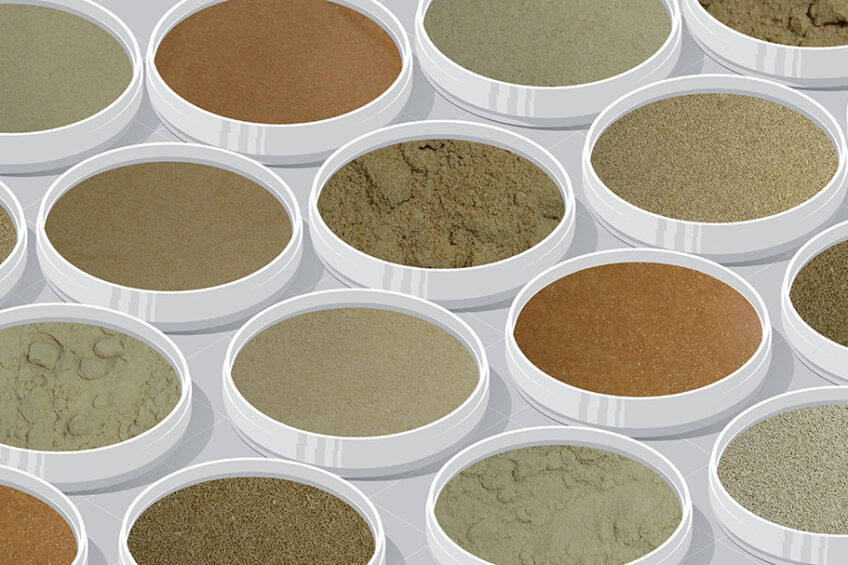
Recent studies have led to a more accurate determination of the composition of Se-yeast and revealed higher level of inorganic selenium than previously believed. According to these findings, the characterisation of Se-yeast as a full organic form of Se might be questioned.
For many years, the efficiency of organic selenium (Se) sources, and of seleno-yeasts (SY) in particular, has been linked to the level of selenomethionine (SeMet), making the evaluation of the Se content and its form crucial to ensuring their bio-efficacy. With this composition and product specification being so critical, SY have a regulatory minimum level of 97-99% of total Se in the form of organic Se, as well as a minimum of 63% of total Se as SeMet. Recent analytical improvements have made it possible to measure an additional inorganic Se form, i.e., Elemental Se (Se0), which has been previously uncharacterised in products. When applied to SY, it better differentiates inorganic and organic selenium and, therefore, Se0 should now be taken into account to obtain a precise evaluation of the variable composition of SY. New questions could also arise related to the categorisation of these Se forms and their nutritional significance.
Selenium is an essential trace mineral for animal nutrition, largely because of its key role in antioxidant defense, immunity and inflammatory modulation processes. Since most feed ingredients throughout the world are Se-deficient, Se dietary supplementation is a standard commercial practice. Se is included in livestock premixes in either inorganic forms (mainly sodium selenite), which are known to have a very low bio-efficacy, or organic forms, such as inactivated SY or in pure chemically synthetised forms (SeMet, hydroxy-selenomethionine: OH-SeMet), which are known to have higher bio-efficacy. It is well known that the SeMet content of SY varies to a great extent from supplier to supplier, as well as from production batch to batch. The manufacturing process for SY involves feeding a growing yeast, mainly Saccharomyces cerevisiae, inorganic Se, and allowing the yeast to synthesize some amounts of SeMet and non-specifically incorporate it into yeast proteins in the form of SeMet. It is known that the SY production technology is quite complex, and the efficiency of SeMet synthesis and its incorporation in the yeast depends on many factors (the fermentation conditions, yeast strain, the Se addition protocol, base medium, energy sources (molasses), pH, temperature, shaking speed, aeration, inoculum size, incubation time, and inorganic Se concentration, which is highly toxic). The management of all these factors is difficult to standardise, and this explains the large variability in the efficiency of the process. This variability leads to large variations in the content of SeMet, the main driver of Se bio-efficacy in livestock animals. The Se composition of 13 fresh commercial SY samples from different batches (CNCM I-3060, CNCM I-3399, NCYC R397, NCYC R645 and NCYC R646) has recently been investigated using new state of the art analytical methods. These SY are authorised as feed supplements with a product specification requirement of a minimum of 97% of the total Se in the form of organic Se as well as a minimum of 63% of total Se as SeMet.
High variability in selenomethionine in Se-yeast product
The high variability in the proportion of SeMet in SY has been known for some time. Indeed, several peer reviewed studies, as well as authorization opinions, have reported different ranges of variability (from 50 to 75%). This new evaluation of freshly sourced products confirms the above-mentioned variability of the SeMet proportion, although the total Se concentrations of the investigated SY matched the labelled indications perfectly (Figure 1). The percentage of SeMet has been found to vary from 19% to 72%, while SY specifications indicate a minimum of 63%. Among the 13 tested SY, eight contained less than 63% of total Se in the form of SeMet and did not match the product specifications, and only five were above this minimum level of SeMet. The various factors mentioned above explain this variability.
Figure 1 – Se specification compared to the total Se (%) of various fresh commercial seleno-yeast (SY) products.
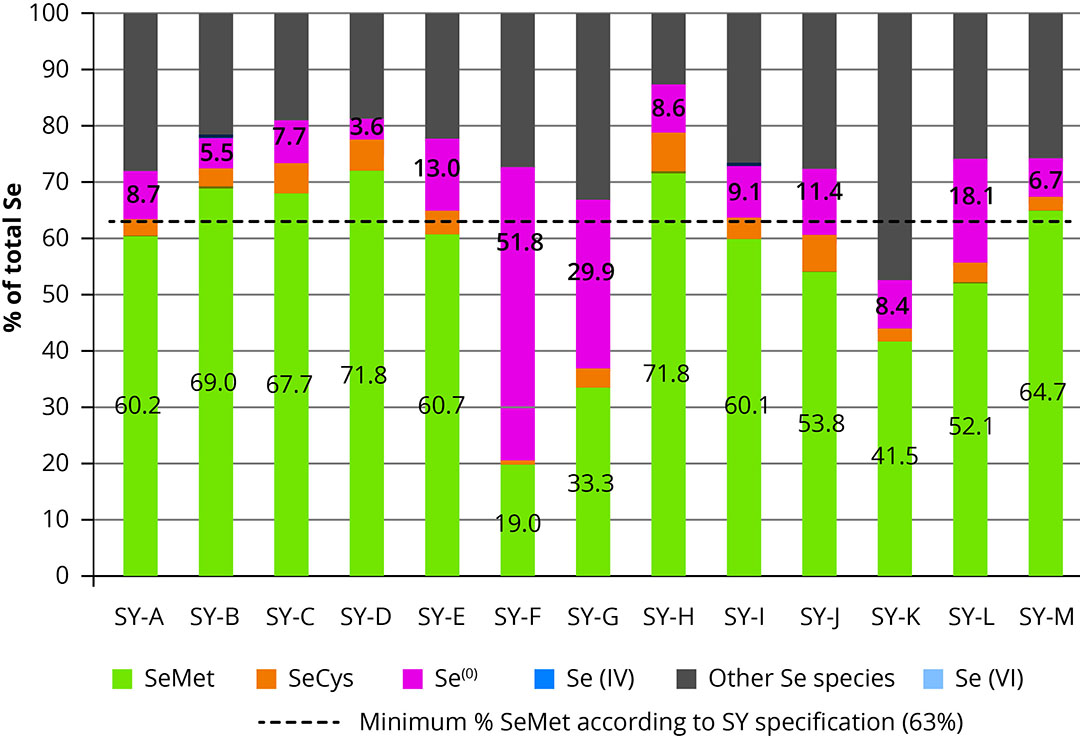
Is selenocysteine present in Se-yeast products?
Se is a non-essential element for yeasts, because, unlike other higher organisms, yeasts do not have any genes coding for selenoproteins, the biologically functional forms of Se which have the specificity of containing a selenocysteine (SeCys) amino acid. It has recently been found that part of the SeMet present in SY could also be nonspecifically oriented toward the trans-sulfuration pathway, thus resulting in the incorporation of non-specific SeCys in yeast proteins. However, such SeCys, if fed to animals, cannot be stored in the same way as SeMet or used directly during selenoprotein synthesis, because of the compulsory in situ selenoprotein synthesis mechanism. In fact, dietary SeCys has been shown to be similar to sodium selenite, in terms of animal bio-efficacy. Furthermore, the proportion of SeCys has generally been reported to be between 10 and 22% in SY products, although the latest performed measurements have shown the presence of only 1.2 to 6.6% of SeCys (Figure 1).
Other organic Se species in Se-yeast products
The specifications of the SY currently on the market are 97-99% of organic Se, mainly SeMet (63%), and the remaining organic Se species, are normally categorised as variable amounts of SeCys, water-soluble selenometabolites and unknown Se species. Many of these other organic Se compounds have been reported and characterised, in different SY. It is now thought that SY could account for more than 100 qualitatively characterised Se species. However, despite the availability of advanced analytical technologies, a mass balance of the identified Se organic species and the assumed total organic Se has not yet been achieved. Therefore, these other Se species need further investigations.
Quantification of classic inorganic Se species in Se-yeasts
It is generally accepted that SY products only contain residual concentrations of inorganic Se as selenite (Se-IV) or selenate (Se-VI), which has been confirmed by the current study on 13 SY samples (Figure 1). Up until now, only the total Se, SeMet and inorganic Se (Se-IV and Se-VI) proportions in SY were considered. However, these proportions of inorganic Se have recently been questioned, as a result of the availability of advanced new analytical methods.
Elemental Se, a newly detected inorganic Se species in Se-yeasts
In SY, organic Se has always been considered the difference between total Se and inorganic Se, where inorganic Se, as previously mentioned, is limited to Se-IV and Se-VI. However, as a result of the advancement of analytical methods, the detection and accurate quantification of elemental Se (Se0) in SY has recently been reported. This newly identified Se0 represents an additional inorganic form of Se. Vacchina et al. 2021, recently developed an accurate method for quantifying Se0 in SY. The authors found that the proportion of Se0 present in seven SY on average represented 10-15% of the total Se and could even represent as much as 40%. Se0 has recently been measured in 13 SY samples, using the same method, and it has been shown that the proportion of Se0 varied between 3.6% and 51.8% (Table 1).
Considering the sum of the inorganic Se species (Se-IV, Se-VI and Se0), the proportion of the organic Se in all the products was far below the specification of 97%, (Figure 2). When you take into account the complex fermentation mixture used in the SY production process, and the fact that sodium selenite (the source of Se in SY production) can be reduced to Se0 by various reducing agents, the precipitation of Se in the form of Se0 is a reaction that is very likely to occur. Therefore, the Se0 concentration can now be measured by using the newly advanced analytical techniques, and has been declared by SY manufacturers in order to improve transparency regarding the Se forms contained in such products. Furthermore, pure organic Se sources, including SeMet, Zn-SeMet and OH-SeMet, have been shown to have no detectable Se0. In fact, these pure forms only deliver Se as SeMet, which is an important step in building Se reserves in the body, and this, in turn, can help alleviate the impact of commercially relevant stress conditions, improve the adaptability of livestock animals, and help maintain their health, with contributes to their productivity and reproductive performance.
Figure 2 – The organic and inorganic Se content compared to the total Se (%) of various fresh commercial Se-yeast (SY) products.
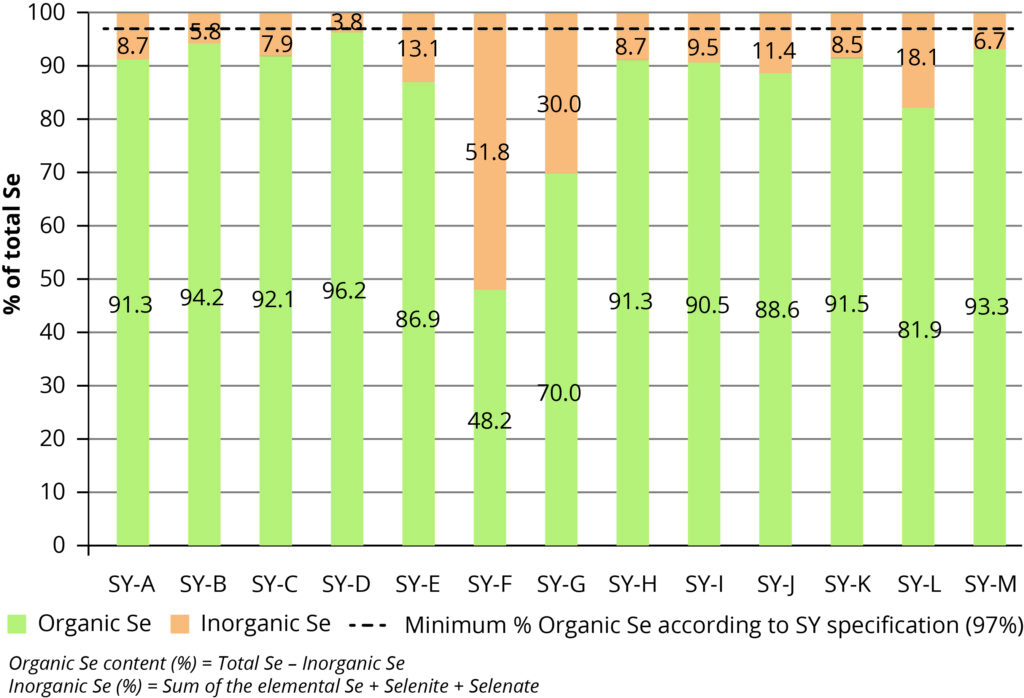
Conclusion
The recent advances in analytical methodologies have led to an increasingly accurate, reliable and comprehensive determination of the composition of SY. These analyses reveal the presence of inorganic Se0, which explains much of the previously unknown Se species. These findings demonstrate that the SY products used in animal nutrition contain far less than 97% of total Se as organic Se. Thus, the proportion of inorganic Se in SY products should be revised and, consequently, a complete characterisation of organic Se species should also be performed. According to these findings, the characterisation of SY as a full organic form of Se can now be questioned and, consequently, end users and the industry will now have the opportunity to make a more thoughtful choice when it comes to deciding how much to invest in an organic form of Se.



